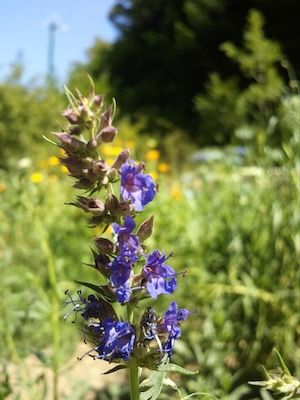HYSSOP
I- Nomenclature
Latin name: : Hyssopus officinalis
Family : Labiatae
Common names: Hyssop, Garden Hyssop1
Etymology
The Greek word, hyssopos, may have derived from the Hebrew, ezob, or holy herb , as it was used to purify temples and for the ritual cleansing of lepers.
II- Legends and traditions
It is one of the oldest known plants, with biblical and sacred origins. The Bible opposes it to the cedar of Lebanon and the Church makes it the vehicle of its southern water: "Asparagus me, Domine, hyssopo, and mundabor ....".[1]
III- Botanical description
Description: Plant with woody stems at the base, forming a tuft up to 40 to 50 cm in height.
Leaves opposite, oblong, glandular, deciduous, falling at the first cold.
Sessile flowers (flowering from July to September) arranged in a terminal spike, corolla blue, sometimes pink.
Fruit consisting of four achenes.
Root large, branchy, covered with abundant hair.
The plant's scent is aromatic and camphoric, which makes it sought out by bees but avoided by herds.
Habitat: The Mediterranean region, in particular in the Alpes-Maritimes and the Var, on bare and stony hillsides exposed to the south.
Parts used: Leaves, aerial parts and essential oil.
IV- Active ingredients
|
Essential oil |
|
• Essential oils • terpene ketones: pinocamphone • terpenes • thujone • bitter principles • tannins |
V- Therapeutic uses
Properties
|
• Antiseptic • balsamic • beaker • respiratory decongestant • expectorant • mucolytic • stomachic • bitter tonic |
Indications
- Aerial parts
Mainly used as an expectorant for bronchitis, colds affecting the lungs and asthma. Also used for flatulence and colic. They promote sweating in case of colds and flu.
- Essential oil
It promotes alertness and is used as a tonic for the nervous system, use for fatigue related to nervous problems, overwork, anxiety or depression. It can be very helpful in relieving feelings of grief and guilt. In inhalation, the essential oil of hyssop exerts a very great expectorant action. It has the property of liquefying the mucus accumulated in the bronchi during lung diseases or influenza. Inhalation relieves asthma, bronchitis, sinus congestion, cold and flu symptoms, cough and shortness of breath.
Dosage
- Aerial parts
Infusion: leaves and flowers: 10gr / liter. Let infuse 10min. Drink 3 to 5 cups / day. Drink hot at the onset of colds and flu. Also take for digestive problems related to nerves.
Tincture: 15 drops 2 times a day in water or herbal tea. Combine with other expectorant herbs, such as licorice, elecampus or anise for bronchitis and stubborn coughs.
Syrup: 100 gr of flowering tops in a liter of water. 1.5 kg of sugar. Drink a glass of bordeaux a day for a cough. Combine with mullein or licorice for stubborn coughs or lung weakness.
- Essential oil
Massage: dilute 10 drops of hyssop oil in 20ml of almond or sunflower oil and massage on the chest in case of bronchitis or pulmonary cough. Combines with thyme and eucalyptus.
Bath: Add 5-10 drops to a bath for nervous fatigue, melancholy or grief. Inhalation: Bring 500 ml of water to a boil. Remove from heat, place on a table and add 3 to 10 drops of an essential oil, without exceeding 10 drops. Inhale. Repeat the operation 2 or 3 times a day. Indicate in case of respiratory tract problems.
VI- Precaution of use
Contraindication
Do not use during pregnancy, in epilepsy, hypertensive, nursing women, children under 8 years old.
Unwanted effects
Do not use more than 15 days because it has a neurotoxic effect.
Interactions
To be used with a softening plant (mauve) because its essential oil is irritating.
Caution
As the essential oil can cause epileptic seizures, it should only be used on medical prescription.
1 https://www.cloverleaffarmherbs.com/hyssop/



